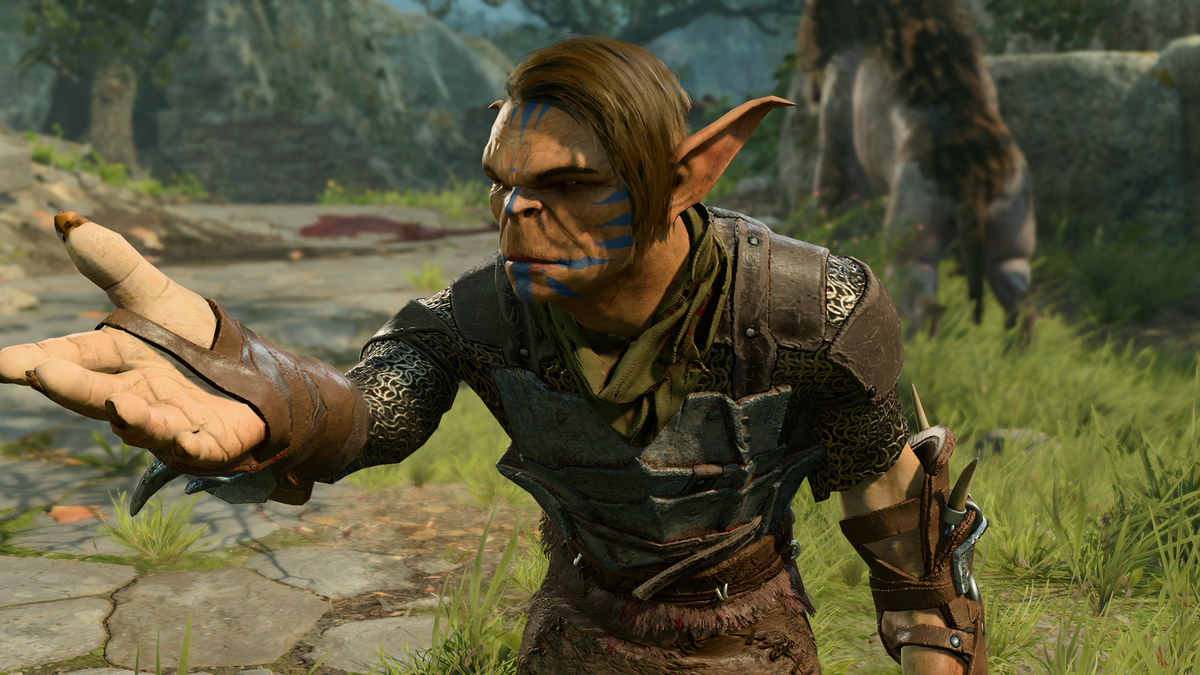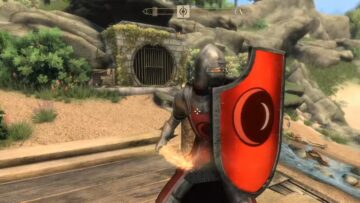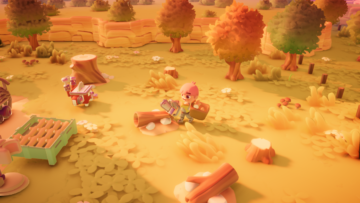
I’ve struggled at times on Baldur’s Gate 3‘s normal difficulty, so I can only imagine how it feels for players who are brand new to D&D or Larian RPGs. With very little explanation, it chucks hotbars full of terms like “bonus action,” “cantrip,” spell slot,” and so much more at players. If it feels like you missed a tutorial, you’re not the only one, but in an interview with PC Gamer last week, Larian founder Swen Vincke contested that there is a tutorial in Baldur’s Gate 3, just not a traditional step-by-step guide. It’s all of Act 1.
“If you pay very close attention to Act 1, you will see that it’s actually a very long tutorial,” Vincke said. “Systems are being shown to you. The AI shows you a lot of things, and makes you realize [how they work], maybe sometimes subconsciously, but you figure things out. You discover increasingly sophisticated challenges, where you will always find a way, because there’s always multiple solutions, anyway. But you might discover and stumble upon something that’s possible, and from now on, it becomes part of the arsenal that you can use to play the game.”
That’s all been true in my experience: I’ve learned a lot from blundering around in the first act, including by copying the things NPCs do in combat to learn that shoving a powerful enemy into a chasm is a valid way to win a fight, for example.
It’s not a flawless learning experience, though, as evidenced by the amount of testing I had to do just to explain how Baldur’s Gate 3 co-op works, and the number of people I know who, many hours in, still had no idea what “DC” stands for or how Armor Class relates to dice rolls. Even having D&D experience only goes so far in Baldur’s Gate 3. In my tabletop D&D games, at least, players spend a lot of time discussing whether or not it’s too meta-gamey to take a long rest in a pit of bones, but Baldur’s Gate 3 mostly assumes that you’re going to jam that long rest button frequently without worrying that you’re cheesing the system—story progression depends on it at times. Some players have found that intuitive, but I didn’t. Also, if you’re not making your characters jump all the time, you should be. Jumping solves so much.
Vincke is aware that players are going to miss things, but that’s not a bad thing from his perspective.
“I mean, people spend 30 hours before they realize they can move an object,” Vincke said. “And then they find that—’Oh my God’—and then maybe in the second playthrough, they discover that they can stack things to make stairs, and so they can climb on top of things. Now suddenly, the third dimension becomes much more accessible.”
Guilty! I kept noticing advice about moving objects in the loading screens but misunderstanding the instruction to drag them (you literally click and drag the object in the world, not from your inventory), even though I’d played Divinity: Original Sin 2 where it works the same. There’s a lot to learn and remember.
“And then there’s people that take Storm Sorcery and can fly from day one,” Vincke continued. “So it’s that type of game. It guarantees you that there’s always multiple ways of going through it. When you’re confronted with a problem, there’s enough ways for you to figure it out, as long as you try a couple of things. And generally what you see is that, once people figure one thing out and say, ‘I didn’t think that was possible,’ that’s when they get hooked on the game, because then they say, ‘Ah, this is possible. Maybe this is possible. Oh, can I do this?’ And that’s where the systemic nature of the game, the simulation, comes to life. And that’s where really all the fun comes from.”
After 50 hours mucking about in the first two acts, I do continue to be surprised by my own discoveries, as well as what I hear from players who’ve had very different experiences. According to Vincke, playtesters were still discovering new strategies on their fourth playthroughs, such as surprising ways to kill a major boss that “they wouldn’t have come up with the first time.”
My intuition is that Vincke’s right, and that Baldur’s Gate 3 would have suffered from any kind of protracted, step-by-step tutorial. I am sometimes frustrated when I’m not sure whether I haven’t understood something or I’ve just encountered a bug, but the immediate invitation to experiment freely and make consequential decisions is what hooked me on Baldur’s Gate 3, same as in Divinity: Original Sin 2.
As a consequence, though, the PC Gamer team is in agreement that making a new Baldur’s Gate 3 character after 20 hours is a valid decision, or maybe even a recommended one. That’s what a lot of us have done after working out combat and party composition tactics and checking out the consequences of early decisions.
That’s not great advice for those who have other things to do at night besides put in Baldur’s Gate 3 hours, and doing a test run before committing isn’t a sterling example of the spirit of roleplaying, but I assume we’re all already spending hours repeating fights with egregious save scumming, so what’s one or two full restarts on top of that?
- SEO Powered Content & PR Distribution. Get Amplified Today.
- PlatoData.Network Vertical Generative Ai. Empower Yourself. Access Here.
- PlatoAiStream. Web3 Intelligence. Knowledge Amplified. Access Here.
- PlatoESG. Automotive / EVs, Carbon, CleanTech, Energy, Environment, Solar, Waste Management. Access Here.
- PlatoHealth. Biotech and Clinical Trials Intelligence. Access Here.
- ChartPrime. Elevate your Trading Game with ChartPrime. Access Here.
- BlockOffsets. Modernizing Environmental Offset Ownership. Access Here.
- Source: https://www.pcgamer.com/larian-boss-says-we-should-think-of-baldurs-gate-3s-entire-first-act-as-the-tutorial
- :is
- :not
- :where
- $UP
- 1
- 20
- 30
- 50
- a
- About
- accessible
- According
- Act
- Action
- acts
- actually
- advice
- After
- Agreement
- AI
- All
- already
- also
- always
- am
- amount
- an
- and
- any
- anyway
- ARE
- around
- Arsenal
- AS
- assume
- assumes
- At
- attention
- aware
- Bad
- BE
- because
- becomes
- been
- before
- being
- besides
- Bonus
- BOSS
- brand
- Brand New
- Bug
- but
- button
- by
- CAN
- challenges
- character
- characters
- chasm
- checking
- class
- click
- climb
- Close
- Cms
- combat
- come
- comes
- committing
- composition
- Consequences
- consequential
- continue
- continued
- copying
- Couple
- day
- dc
- decision
- decisions
- depends
- different
- Difficulty
- Dimension
- discover
- discovering
- discussing
- do
- doing
- done
- Early
- enough
- Entire
- Ether (ETH)
- Even
- evidenced
- example
- experience
- Experiences
- experiment
- Explain
- explanation
- far
- fight
- fights
- Figure
- Find
- First
- first time
- For
- found
- founder
- Fourth
- frequently
- from
- frustrated
- full
- fun
- game
- Games
- generally
- get
- God
- Goes
- going
- guarantees
- guide
- had
- Have
- having
- hear
- his
- HOURS
- How
- HTTPS
- i
- idea
- if
- imagine
- immediate
- in
- Including
- increasingly
- Interview
- into
- intuition
- intuitive
- inventory
- invitation
- isn
- IT
- jump
- just
- kept
- Kill
- Kind
- Know
- Last
- LEARN
- learned
- learning
- least
- Life
- like
- little
- loading
- Long
- Lot
- major
- make
- MAKES
- Making
- many
- maybe
- me
- mean
- might
- missed
- misunderstanding
- more
- mostly
- move
- moving
- much
- multiple
- my
- Nature
- New
- night
- no
- normal
- now
- number
- object
- objects
- of
- oh
- on
- once
- ONE
- only
- or
- original
- Other
- out
- own
- part
- party
- Pay
- PC
- PC Gamer
- People
- perspective
- PIT
- plato
- Plato Data Intelligence
- PlatoData
- Play
- played
- players
- possible
- powerful
- Problem
- progression
- put
- RE
- realize
- really
- recommended
- remember
- REST
- right
- rolls
- RPGs
- Run
- s
- Said
- same
- Save
- say
- says
- screens
- seasonal
- Second
- see
- should
- shown
- Shows
- simulation
- slot
- So
- so Far
- Solutions
- Solves
- some
- something
- sophisticated
- SPELL
- spend
- Spending
- spirit
- stack
- stands
- sterling
- Still
- Storm
- strategies
- such
- suffered
- sure
- surprised
- surprising
- systemic
- Systems
- T
- tactics
- Take
- team
- terms
- test
- Test run
- Testing
- that
- The
- the world
- their
- Them
- then
- There.
- they
- thing
- things
- Think
- Third
- this
- those
- though?
- Through
- time
- times
- to
- too
- top
- traditional
- true
- try
- tutorial
- two
- type
- understood
- upon
- us
- use
- Ve
- very
- was
- Way..
- ways
- we
- week
- WELL
- were
- What
- when
- whether
- WHO
- will
- win
- with
- without
- Work
- working
- working out
- works
- world
- would
- wouldn
- you
- Your
- zephyrnet









